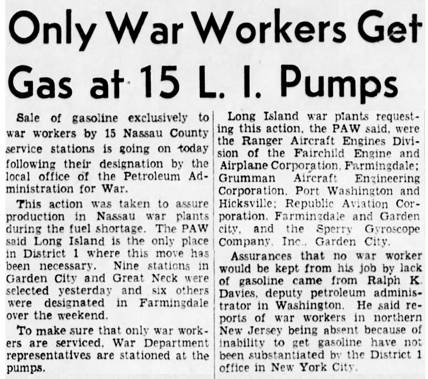Doing Without Driving (almost)
During World War I, Washington had - temporarily - nationalized the country's railroads under the banner of the United States Railroad Association. Despite many Americans' inbred abhorrence of anything that smacked of socialism, people accepted this, and other far-reaching Federal emergency measures, rather quietly. Locomotives were reallocated from the railroads which owned them to ones which the government thought needed them more. Locomotive builders had to construct new engines only according to government-devised standard designs (much as automakers of the era had to build standard Liberty Trucks of a common design). The government decided where trains went when, and what they carried.
In World War II, government control of industry was more widespread. For example, the demand for one of Grumman's most effective aircraft, the Avenger torpedo bomber, was so high that General Motors factories in California were directed to build Avengers. By the war's end, GM had built more of them than Grumman had. Similar stories can be told about all the era's big American automakers. Studebaker made trucks for the Army, and engines for bombers and big transports. Packard made engines for different branches of the military, most notably the one for the P-51 Mustang. Hudson's efforts included engines for the landing craft used on D-Day, and more than 33,000 20mm cannons that were used by the Navy. One of the Chrysler companies built Sherman tanks. Nash made the engine for the F4U Corsair.
During the time that automotive companies worked on war projects, they were too busy - and they were forbidden - to make vehicles for civilians. Americans would have to keep their old cars, the majority of which had been purchased in the 1930s, going until peace arrived.
Gasoline consumption was managed in a multiple ways. Gas stations frequently were closed one day a week. There were special gasoline ration cards, issued to an individual for use only with her/his own car. With the card came a matching windshield sticker, which classified the owner according to occupation. A defense worker could buy more gallons at once than the ordinary person could; a doctor or nurse could buy still more. Emergency, VIP, and farm vehicles all had their own categories. In and around Hicksville, there were so many defense workers that certain gas stations were set aside just for them.

Brooklyn Daily Eagle, August 25, 1943
War Production Board Poster
sarahsundin.com
Automobile tires posed a serious problem. In 1940, synthetic rubber was a new product, still being tested. It was anticipated that, apart from those involved in the early tests, American civilians and military personnel would have to ride through the war on natural rubber* - and early in 1942, Japan had seized the nations that supplied over 90% of that. Thus, rubber was much harder to obtain than crude oil, which led to the belief that gas rationing, and the lowering of America's speed limits to 35 mph, were measures taken more to make the nation's tires last longer than to save gas.
Unless civilians' jobs put them in special categories, they were allowed to own no more than five tires each. They would not be able to purchase new tires while the war continued, but - and only if given permission by local officials - they could have worn-out tires recapped.
*As things worked out, different synthetic rubbers were introduced during wartime for a number of small products, including soles for shoes. Synthetic tires were approved for use by the military during the latter years of the war, but I do not believe that (apart from testing) any were made available to civilians in wartime.
***

